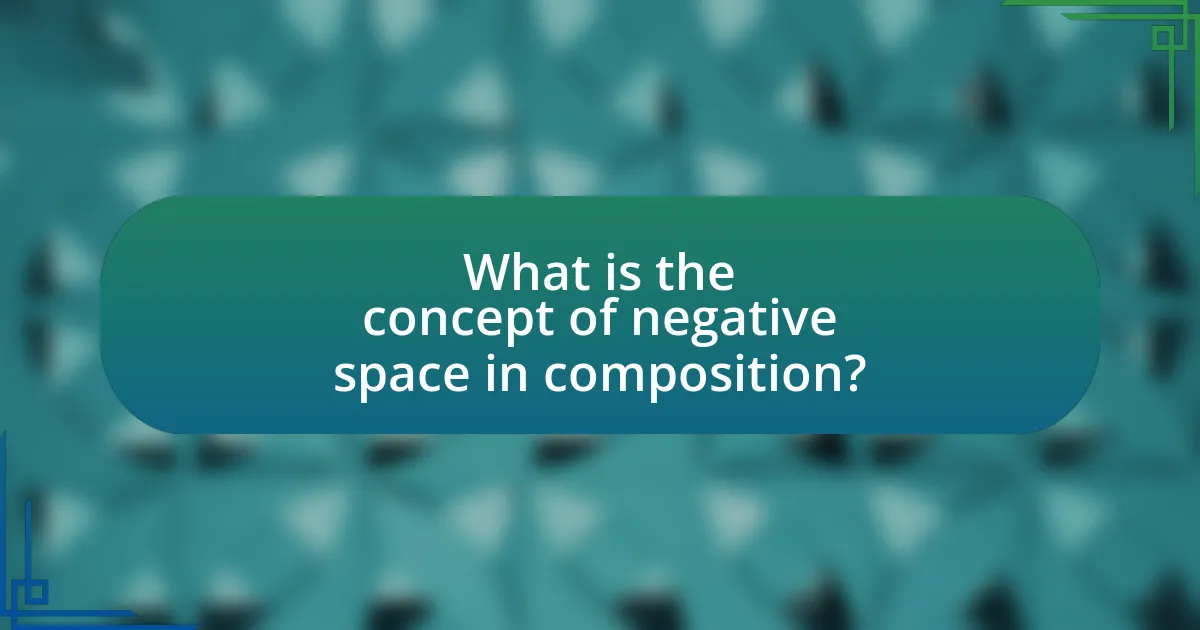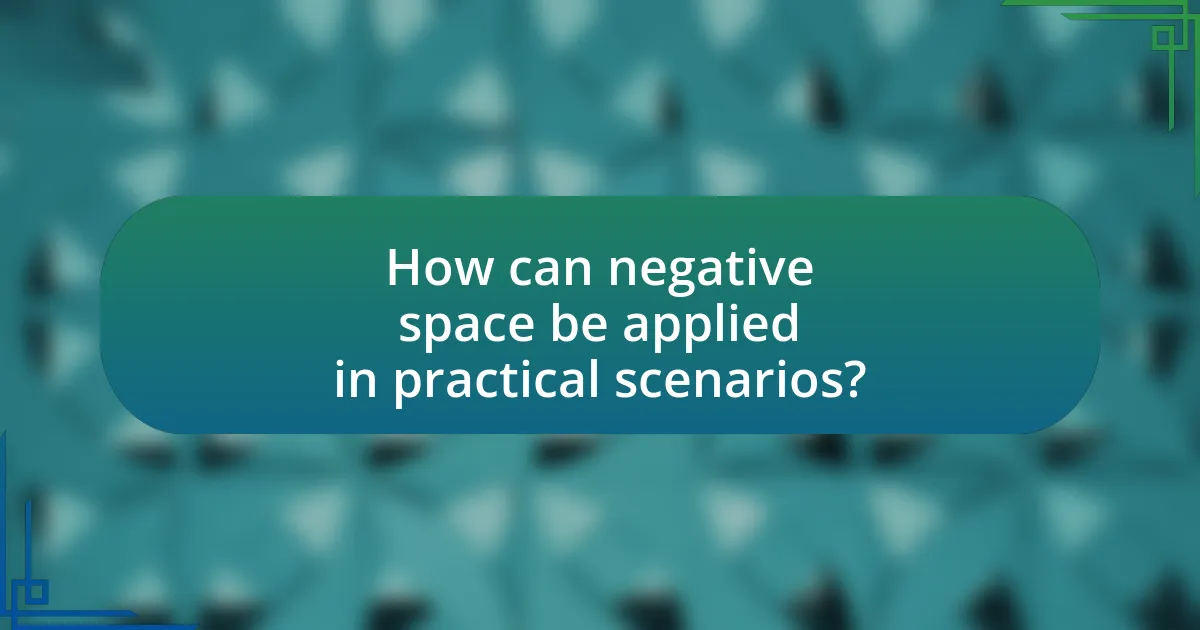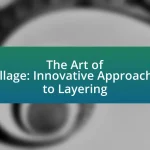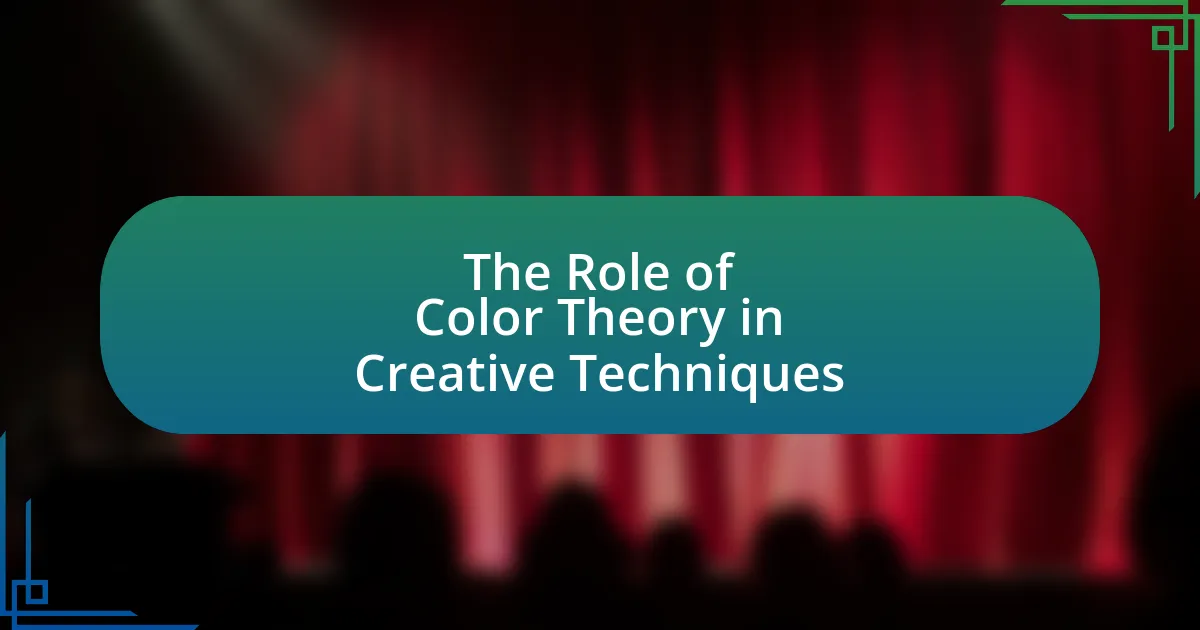The article “The Power of Negative Space: Techniques for Effective Composition” explores the concept of negative space in visual composition, emphasizing its role in defining boundaries, enhancing balance, and guiding viewer perception. It discusses how negative space influences visual clarity and emotional responses, providing examples from various art forms, including photography and graphic design. Key techniques for effectively incorporating negative space, common mistakes to avoid, and practical applications in design projects are also examined, highlighting its significance in creating engaging and aesthetically pleasing compositions.

What is the concept of negative space in composition?
The concept of negative space in composition refers to the area surrounding and between the subjects of an image or design. This space is crucial as it helps to define the boundaries of the positive space, which is the main subject, and can enhance the overall visual impact by creating balance and focus. Effective use of negative space can lead to a more engaging composition, as it allows the viewer’s eye to navigate the image more easily and can evoke emotions or convey messages without the need for additional elements.
How does negative space influence visual perception?
Negative space significantly influences visual perception by shaping how viewers interpret and engage with an image. It creates a balance between the subject and its surroundings, allowing the viewer to focus on the main elements while also providing context. Research indicates that effective use of negative space can enhance clarity and guide the viewer’s eye, making compositions more aesthetically pleasing and easier to understand. For instance, in graphic design, the strategic use of negative space can lead to a more impactful message, as seen in logos like FedEx, where the space between the letters forms an arrow, symbolizing speed and precision.
What are the psychological effects of negative space on viewers?
Negative space significantly influences viewers’ psychological responses by creating a sense of balance and focus within a composition. This technique allows the viewer’s eye to rest, enhancing the overall perception of the artwork or design. Research indicates that negative space can evoke feelings of calmness and contemplation, as it reduces visual clutter and directs attention to the main subject. For instance, studies in visual perception show that compositions utilizing negative space can lead to increased viewer engagement and emotional resonance, as they encourage deeper reflection on the subject matter.
How does negative space contribute to balance in a composition?
Negative space contributes to balance in a composition by creating visual harmony and guiding the viewer’s eye. It allows the main subjects to stand out while providing breathing room, which prevents overcrowding and enhances focus. For instance, in graphic design, the effective use of negative space can lead to a more aesthetically pleasing layout, as seen in the logo design of FedEx, where the space between the letters forms an arrow, symbolizing speed and precision. This strategic use of negative space not only balances the composition but also conveys meaning, demonstrating its critical role in effective visual communication.
Why is negative space important in various art forms?
Negative space is important in various art forms because it enhances composition by creating balance and directing viewer attention. In visual arts, negative space helps to define shapes and forms, allowing the subject to stand out more prominently. For example, in the works of artists like Henri Matisse, the use of negative space contributes to the overall harmony and flow of the composition, making the artwork more engaging. Additionally, studies in design psychology indicate that effective use of negative space can improve visual clarity and comprehension, as it allows the viewer to focus on the intended subject without distraction.
What role does negative space play in photography?
Negative space in photography serves to enhance the subject by providing visual breathing room, thereby drawing attention to the main focal point. This technique allows photographers to create balance and emphasize the subject’s importance within the composition. For instance, a study published in the Journal of Visual Communication and Image Representation highlights that images utilizing negative space can evoke stronger emotional responses from viewers, as the empty areas guide the eye and create a sense of context. By strategically incorporating negative space, photographers can achieve a more impactful and aesthetically pleasing image.
How is negative space utilized in graphic design?
Negative space is utilized in graphic design to create balance, enhance visual hierarchy, and improve readability. Designers strategically use the empty areas around and between subjects to draw attention to the main elements, allowing for a clearer message. For instance, the logo of FedEx employs negative space to form an arrow between the letters “E” and “x,” symbolizing speed and precision. This technique not only makes the design more memorable but also reinforces the brand’s identity. By effectively incorporating negative space, designers can achieve a more engaging and aesthetically pleasing composition.

What techniques can be used to effectively incorporate negative space?
To effectively incorporate negative space, designers can utilize techniques such as strategic placement of elements, contrast, and framing. Strategic placement involves positioning subjects in a way that allows the surrounding space to enhance their prominence, thereby creating a visual balance. Contrast can be achieved by using colors or textures that differentiate the subject from the negative space, making the subject stand out more distinctly. Framing involves using elements within the composition to create a border around the subject, drawing attention to it while simultaneously emphasizing the negative space. These techniques are supported by principles of design that highlight the importance of balance and focus in visual communication.
How can artists identify and utilize negative space in their work?
Artists can identify and utilize negative space by consciously observing the areas surrounding their subjects and recognizing the shapes formed by these spaces. This practice involves stepping back from the artwork to see the composition as a whole, allowing artists to discern how negative space interacts with positive elements. For instance, the use of negative space can enhance balance and focus within a piece, as seen in the works of artists like Henri Matisse, who famously employed negative space to create dynamic compositions. By analyzing the relationships between objects and their surroundings, artists can strategically use negative space to guide the viewer’s eye and create a more engaging visual experience.
What methods can be employed to enhance negative space in a composition?
To enhance negative space in a composition, artists can employ methods such as simplifying elements, adjusting scale, and utilizing contrast. Simplifying elements involves removing unnecessary details to allow the negative space to stand out, which can create a more focused composition. Adjusting scale means varying the size of objects within the composition to emphasize the surrounding negative space, making it more prominent. Utilizing contrast, such as light versus dark or textured versus smooth areas, can also draw attention to negative space, enhancing its visual impact. These methods are supported by design principles that emphasize the importance of balance and clarity in visual art.
How can framing techniques improve the use of negative space?
Framing techniques can enhance the use of negative space by guiding the viewer’s focus and creating a balanced composition. By strategically positioning elements within the frame, artists and photographers can emphasize the emptiness around the subject, thereby highlighting its significance. For instance, using a tight frame can isolate the subject against a vast background, making the negative space more pronounced and impactful. This method is supported by principles of design, where effective use of negative space can lead to a more aesthetically pleasing and engaging visual experience.
What are some common mistakes when using negative space?
Common mistakes when using negative space include overcrowding the composition, failing to balance positive and negative space, and neglecting the purpose of negative space. Overcrowding occurs when too many elements are included, which diminishes the impact of the negative space. Failing to balance positive and negative space can lead to a visually unappealing composition, as one may overpower the other. Neglecting the purpose of negative space results in a lack of clarity and focus, as the viewer may struggle to understand the intended message or subject. These mistakes can hinder the effectiveness of the overall composition.
How can overuse of negative space detract from a composition?
Overuse of negative space can detract from a composition by creating a sense of emptiness that overwhelms the intended subject. When excessive negative space is present, it can lead to confusion about the focal point, making it difficult for viewers to engage with the main elements of the design. Research indicates that balance is crucial in visual composition; for example, a study published in the Journal of Visual Communication found that compositions with a harmonious balance of positive and negative space are perceived as more aesthetically pleasing and easier to interpret. Thus, while negative space is a powerful tool, its overuse can result in a lack of clarity and focus in the overall composition.
What are the signs of poorly balanced negative space?
Signs of poorly balanced negative space include overcrowding of elements, lack of visual breathing room, and uneven distribution of space that leads to a chaotic composition. Overcrowding occurs when too many elements are placed close together, making it difficult for the viewer to focus on any single aspect. A lack of visual breathing room results in a cramped appearance, which can overwhelm the viewer and detract from the overall message. Uneven distribution of space can create a sense of imbalance, where one side of the composition feels heavier than the other, leading to discomfort in viewing. These signs indicate that the negative space is not effectively enhancing the overall composition, which is crucial for achieving harmony and clarity in design.

How can negative space be applied in practical scenarios?
Negative space can be applied in practical scenarios by enhancing visual clarity and focus in design and art. For instance, in graphic design, utilizing negative space can create a more balanced composition, allowing the viewer’s eye to easily navigate the layout. A notable example is the FedEx logo, where the negative space between the “E” and “x” forms an arrow, symbolizing speed and precision. This technique not only improves aesthetics but also communicates messages effectively, as evidenced by studies showing that designs with well-utilized negative space are perceived as more professional and engaging.
What are some tips for beginners to master negative space?
To master negative space, beginners should focus on simplifying their compositions by identifying and emphasizing the areas around their main subjects. This can be achieved by using techniques such as framing, where the subject is surrounded by negative space to draw attention, and contrast, which highlights the subject against a less busy background. Additionally, practicing with different perspectives can help beginners understand how negative space can alter the perception of their subject. Studies in visual perception indicate that effective use of negative space can enhance viewer engagement and comprehension, making it a crucial element in composition.
How can one practice using negative space in everyday photography?
To practice using negative space in everyday photography, one should consciously incorporate empty areas around the subject to enhance composition. This can be achieved by framing subjects against simple backgrounds, ensuring that the surrounding space emphasizes the main focus. For instance, capturing a lone tree in a vast field allows the tree to stand out, demonstrating the effectiveness of negative space. Studies in visual perception indicate that images with ample negative space can lead to a more balanced and aesthetically pleasing composition, as they guide the viewer’s attention to the subject without distractions.
What exercises can help improve understanding of negative space?
To improve understanding of negative space, artists can engage in exercises such as drawing contour lines of objects while focusing solely on the spaces around them. This technique emphasizes the shapes created by the absence of objects, enhancing spatial awareness. Another effective exercise involves creating a composition using only the negative space, where the artist fills in the background while leaving the subject unpainted or unmarked. This method reinforces the importance of negative space in visual balance and composition. Additionally, practicing with cut paper silhouettes can help visualize negative space by allowing artists to see the shapes formed by the absence of material. These exercises are grounded in principles of design that highlight the significance of negative space in creating effective compositions.
What are the best practices for utilizing negative space in design projects?
The best practices for utilizing negative space in design projects include ensuring balance, enhancing focus, and creating visual hierarchy. Designers should strategically use negative space to separate elements, which helps to avoid clutter and directs the viewer’s attention to key components of the design. For instance, the use of ample negative space around a logo can enhance its visibility and impact, as seen in successful branding strategies like Apple’s minimalist approach. Additionally, employing negative space can lead to innovative designs, such as the FedEx logo, which cleverly incorporates an arrow in the negative space between the letters. These practices not only improve aesthetics but also enhance user experience by making designs more intuitive and engaging.
How can negative space enhance branding and logo design?
Negative space enhances branding and logo design by creating visual interest and conveying messages without clutter. This technique allows designers to utilize the space around and between elements to form shapes or symbols that reinforce brand identity. For instance, the FedEx logo cleverly uses negative space to create an arrow between the letters “E” and “x,” symbolizing speed and precision. Such effective use of negative space not only makes logos memorable but also communicates deeper meanings, thereby strengthening brand recognition and emotional connection with the audience.
What strategies can be used to maintain clarity with negative space in layouts?
To maintain clarity with negative space in layouts, designers should strategically balance elements and utilize whitespace effectively. This involves ensuring that there is sufficient space around key components to enhance visibility and comprehension. For instance, using generous margins and padding can prevent overcrowding, allowing the viewer to focus on the main content without distractions. Research indicates that layouts with appropriate negative space improve user engagement and information retention, as demonstrated in studies by the Nielsen Norman Group, which found that users are more likely to absorb information when it is presented clearly and without clutter.




